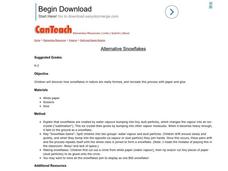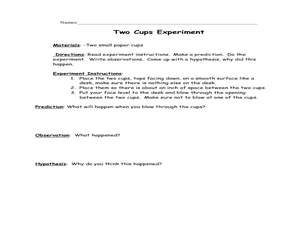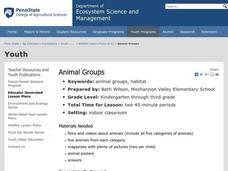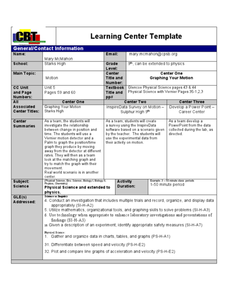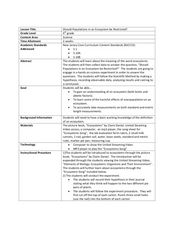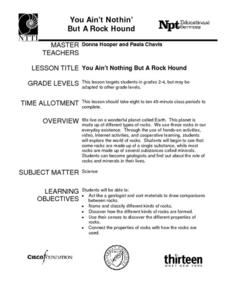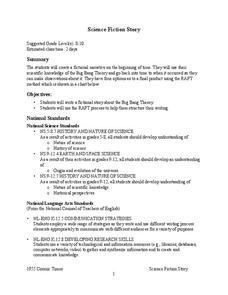Curated OER
Trends of Snow Cover and Temperature in Alaska
Students compare NASA satellite data observations with student surface measurements of snow cover and temperature. They practice data collection, data correlations, and making scientific predictions.
Curated OER
Alternative Snowflakes
Students discover how snowflakes in nature are really formed, and recreate this process with paper and glue. This art lesson plan gets some scientific learning in as well.
Curated OER
Understanding Bernoulli's Principle
Fifth graders explain why we fly. In this space science lesson, 5th graders discuss Bernoulli's prinicple and its relation to flight.
Curated OER
Writing As Criminal Evidence
Students research 2 famous forgery cases. In this forensics lesson, students are introduced to the methods of handwriting and paper analysis. They then use the Internet to study the cases of the Lindbergh baby and Howard Hughes'...
Curated OER
Andy Warhol and Silkscreen Pop Art
Students explore art history by researching famous paintings on-line. In this Andy Warhol lesson, students discuss who Warhol was, his impact on popular art and methods of painting. Students examine his use of silk screen printing and...
Curated OER
Using Density to Identify Wood Types
Learners identify different woods based on their density. In this density lesson plan, students use a triple beam balance to find the mass and a metric ruler for the volume. They look through various wood blocks and identify what type of...
Curated OER
Animal Groups
Students explore animal groups. In this animal science lesson, students use pictures from magazines and classify the animals into five categories. Students share why they categorized the animals the way they did.
Curated OER
Properties of Liquids
Seventh graders explain that liquids are made up of tiny particles and how these spaces allow other particiles to fit in between larger particles. They then plan and carry out simple scientific experiments.
Curated OER
An Arctic Expedition
Students become familiar with the Arctic region and the difficulties of scientific research by designing and developing an expedition to an "unknown" place. They use the library and the Internet in order to do their research. They...
Curated OER
Lewis and Clark: The Language of Discovery
Students replicate some of the trailblazing methods of Lewis and Clark on a fifteen-minute "writing journey" through the school or neighborhood.
Curated OER
Polar Scientists: Polar Science
Research skills are extremely important and they can be linked to any subject. Get your class thinking about scientists that study the polar region, what they do, and how they get funded to continue their research. Each child uses a...
New Mexico State University
Lab 6: Kepler's Laws
A 15-page package thoroughly teaches your physics or astronomy learners about Kepler's three laws of planetary motion. Each one is stated and explained. Class members answer questions, solve problems, and participate in the classic...
Curated OER
"Graphing Your Motion"
Students study the concepts of motion, velocity, and acceleration through graphing their own movement using LoggerPro. They explain the difference between speed and velocity using the weather vane example. They discover the difference...
Curated OER
Wilderness Survival: A Field Practicum
Students are provided with hands-on-field testing of authentic applications from principles pertaining to: Psychology A. Develop a positive, can-do attitude with a high degree of self-reliance that is transferable to human interactions...
Curated OER
Wilderness Survival: A Field Practicum
Students use hands-on field-testing of authentic application from principles pertaining to: Psychology- A. Develop a positive, can-do attitude with a high degree of self-reliance that is transferable to human interactions outside of the...
Curated OER
The World Of Earth Science
For this science worksheet, students examine the topic in order to solidify knowledge covered in the curriculum using puzzles and creative games.
Curated OER
Collect Data Using a Transect Line
Young scholars learn about transect lines through a study of marine debris. In this marine debris lesson, students calculate the items on a transect line and graph them. Young scholars complete a category worksheet.
Curated OER
How about a Little Give and Take?
Middle schoolers design a closed system to test the relationships between plants and animals. They monitor abiotic fluctuations within this living system by using a chemical test kit. They observe how living organisms respond to...
Curated OER
Should Populations in an Ecosystem be Restricted?
Fourth graders experiment to determine how overpopulation effects ecosystems specifically plants. In this ecosystem lesson, 4th graders conduct an ecosystems experiment after listening to Claire Daniel's, Ecosystems. They watch a video,...
Curated OER
You Ain't Nothin' But a Rock Hound
Here is an excellent lesson on rocks! In it, learners explore the world of rocks through the use of video, hands-on activities, and cooperative projects. This outstanding plan is chock full of terrific activities, websites, streamed...
NASA
Dark Matter NASA Conference
Young scholars calculate the escape velocity of planets in our solar system and use that knowledge to calculate the escape velocity for NGC 2300 group. They then suggest reasons for the escape velocity to be higher than possible given...
Curated OER
Doin' The Moonwalk
If you are looking for an outstanding lesson on the Moon for your budding astronomers, look no further! This outstanding plan is full of wonderful, meaningful activities for your charges to engage in. Pupils will discover why there are...
NASA
Science Fiction Story
A lesson allows you to go back in time and see the big bang actually happen. Bazinga! In reality, pupils research the Big Bang Theory and theorize what it would be like to go back in time and see it happen. There are four...
Virginia Department of Education
Historical Models of Atoms
What does the past have to do with today? Young scientists find that answer as they learn more about past chemists and their significant contributions to the field. Pupils use the Internet to research historical figures...



